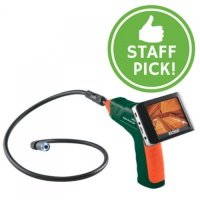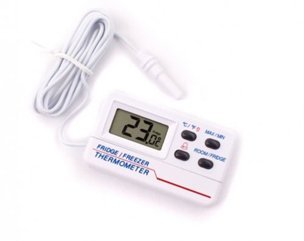How to Avoid Food Poisoning Because of Your Fridge (and How a Fridge Thermometer Can Help)
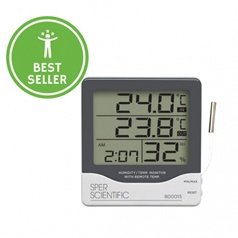
Fridge thermometers are the low-cost and easy way to help you maintain safe temperatures throughout your refrigerator.
Get a scientist’s explanation of why you should be using a home fridge thermometer, what to look for and some best examples of affordable devices.
About Fridge Thermometers

Fridge thermometers are small devices for reading the temperature of fridges and freezers during use. You can get fridge thermometers to suit almost any situation - from basic temperature recording devices to models capable of very accurate measurements that also offer temperature alarms.
What is the Temperature Danger Zone?
You can control two things to ensure your household enjoys quality, safe food - cooking temperature and refrigeration temperature.
Monitoring your refrigeration temperature to ensure it is correct and consistent is crucial.
Here’s why:
Food kept between 5°C to 60°C is outside what experts advise are safe temperature limits. Temperatures beyond the safe zone create the perfect conditions for many types of food poisoning bacteria to flourish.
Table 1 (below) outlines the types of bacteria that can cause food poisoning with the corresponding ideal temperature range for growth and reproduction.
Species |
Ideal temperature range |
|
Salmonella |
5°c to 45°c |
|
Clostridium perfringens |
15°c to 55°C |
|
Staphylococcus aureus |
7°c to 48°c |
|
bacillus cereus |
4°c to 50°c |
|
Campylobacter jejuni |
30°c to 45°c |
Table 1 Common examples of bacteria capable of causing food poisoning with their ideal temperature range
Four Factors Affecting Fridge Temperatures
-
Internal fridge temperature zones
Fridges and freezers have warmer and cooler spots due to their cooling mechanisms and airflow. For example, the back and bottom walls tend to be cooler, while door shelves tend to be warmer by a few degrees. -
Ambient temperature
As summer approaches, it’s important to know that higher ambient temperatures can profoundly affect the cooling efficiency of a fridge or freezer. -
Fridge use
Frequent and prolonged opening of fridge or freezer doors can cause dangerous temperature fluctuations. -
Fridge loading
If you over-packed your fridge, you soon reduce its ability to circulate the cooling air it needs to work safely.
How To Choose A Fridge Thermometer
- MIN/MAX temperature: A fridge thermometer that stores the MIN/MAX temperature recordings over time will show you whether your fridge temperatures have stayed within safe food zones.
- Accuracy: Check that the accuracy of the device you seek matches your needs. Food Standards Australia New Zealand (FSANZ) recommends a thermometer that’s accurate to ±1°c to avoid unhealthy fridge temperature fluctuations.
- Alarms: Some devices offer programmable or preset alarms to alert you whenever the fridge or freezer temperatures move outside acceptable limits.
- External LCD: Because opening and closing fridge doors cause temperature fluctuations — fridge thermometers with internal sensors and external screens are recommended to limit excessive fridge access.
Fridge Thermometer Examples
|
|
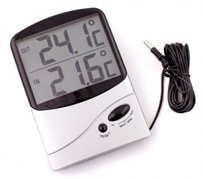
IC7310TM - Jumbo Display In-Out Thermometer
|

Large Display Indoor/Outdoor Thermometer
|
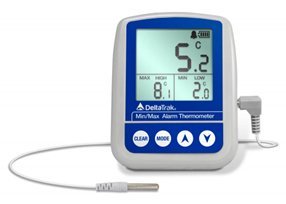
FlashCheck Min-Max Alarm Digital Thermometer
|
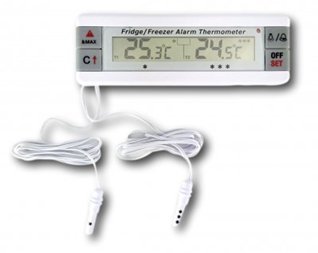
Dual Display Digital Thermometer for Fridge Freezer with Dual Probes
|
The Final Word
Investing in a fridge thermometer is like recruiting a guardian for your fridge! Any of the models in this article will monitor your fridge temperature around the clock to help you ensure constant, energy-efficient temperatures – and safe food. When temperatures breach safe limits, the right fridge thermometer will also provide the insights you’ll need to fix the problem.
Have questions or need some help finding the best fridge thermometer to keep your fridge or freezer safe? Speak with an Instrument Choice Scientist! Call 1300 737 871 or email [email protected].
Learn about safe cooking temperatures here.
Also interesting
The world has woken up – too much CO2 is bad for the planet, and poor indoor air quality is detrimental to people's health and well-being.
CO2 meters are the first line of defence in identifying elevated interior CO2 levels. They pave the way for the essential steps to improve air quality in offices, classrooms, production sites, or any indoor space.
This article spotlights four outstanding and representative commercial models offered by Testo Instruments – a world-leading manufacturer of CO2 meters.
Make sure you’re up to speed on Testo’s CO2 monitoring solutions here

A borescope is an instrument used to inspect narrow or hard-to-reach commercial/industrial systems and equipment. The design, inner workings and functionality of a borescope will vary substantially between brands. To help you distinguish between models and find the best for your needs, our scientists have compiled a list of key terms you will find in borescope camera specifications.
Get the essential terms to help you to choose the best borescope camera for your needs
